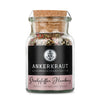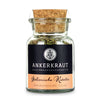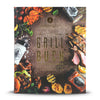Saffron – hand-picked threads
Even if the history and stories are not 100 percent sure where today's came from Name of the spice saffron There are still plausible theories. So he could from the Persian word “zarparan” have been derived, which means something like “golden styles”. The English name “Saffron” probably comes from that Latin, from “safranum”, and countless other countries around the world have developed very similar names for this luxurious commodity.
The scientific name of saffron, Crocus sativus, already reveals which plant family it comes from. It is a matter of a type of crocus, closely related to the spring bloomers that we know from forests and meadows. Saffron blooms purple in autumn and is called the same as the noble luxury spice that is made from it.
The buds bloom in autumn and survive the rest of the year protected in the soil, which should be humus-rich and calcareous. Even though it has an onion bulb, saffron is not a member of the onion family, as is often incorrectly assumed, but rather a type of crocus Iris family. Phew, this botany is sometimes quite complicated. But if you want to call yourself a real connoisseur, you should probably know about this too ;-).
And here's even more expert knowledge: What the borrower calls "threads" when it comes to the spice saffron is actually called "scar branches". They are the part of the plant that is harvested and dried in order to later produce the saffron spice that is ready for sale - either pure or, for example, as a fine salt mix. After the drying process only remains about 20 percent water content included in the stamp threads. However, Spanish saffron in particular will not just dried, but toasted, which in turn gives it a very unique aroma.
Enjoyment with a price: Why is saffron spice so expensive?
The harvest of saffron is probably one of the most complex of all: In painstaking manual work The small, fine red stigma branches are picked from the flower heads. A good picker cannot manage 100 grams of spice threads a day. So you can see that it takes a lot of effort to get just one kilo.
Another complicating obstacle is the flowering time. Because Saffron only blooms once a year: Always only in autumn, and then only for a few weeks. The time window for plantation owners and pickers to stock up on export goods for the year is very small. If you want to buy saffron spice, you have to because of the manual work and the small amount, which is actually obtained during the annual harvest, has to dig so deep into one's pockets. Depending on the provider, saffron spice costs over ten euros per gram.
That's where he comes from, that's what comes in
Most of the growing areas are in countries such as Iran, Kashmir, Spain, Morocco and Afghanistan to find. And even in Germany Saffron is grown in some areas. It is now difficult to determine with certainty where the heavily cultivated plant originally came from. It was probably in the Middle East, but the cultivation of the crocodile plant also began early on in Central Europe, perhaps in the Middle Ages. At that time, saffron already had a hefty price and was said to be would have been worth about as much as a whole horse. Well, would you rather keep a good mount or buy a fantastic seasoning for it...?
You can also buy saffron spice from us: one gram in a pretty test tube with a cork stopperto keep it airtight and preserve the taste. With high “Grade A” quality and free of additives such as sugar or flavor enhancers. They have the reddish threads that are ground or If overcooked, it turns yellow in food instead of red, not even necessary! Because the aroma comes without any fanfare and provides dishes with incomparable taste even in tiny quantities.
How does the rare spice taste?
The taste of spice with a noble character is something completely unique, which is probably best used as slightly bitter, tart and spicy can be described. The scent of the threads is particularly aromatic and straight in Persian cuisine estimated. Speaking of Persian cuisine: Did you know that in addition to saffron, you can also find other tasty dishes here? oriental spices find? For example, try ours Hummus spice!
The bright golden-yellow color that it gives to rice, for example, and the strong taste are a delight for the eyes and the palate. The most typical dishes for using the saffron spice are: the Spanish paella and risotto dishes. The coloring properties of the stigma branches are so intense that they were used as a colorant for centuries ago Simulation of real gold or silver has been used. And its use in the kitchen didn’t remain hidden for long.
When using saffron as kitchen seasoning it is recommended to do this Don't cook for too long. It is best to soak it in warm water beforehand and then put it in the pan or saucepan towards the end of the cooking time. This way the flavor doesn't get overcooked and can develop its full effect in risotto or paella. Also one Pumpkin soup, sauces or pastries such as cakes A small pinch of saffron gives them intensive nuances and an exciting yellow color. Why not try a saffron risotto with shrimp, leek, white wine, vegetable broth, butter, garlic and some parmesan for garnish? Or would you rather have the Spanish paella like you would on holiday in Mallorca – how do you like the luxury threads best?















